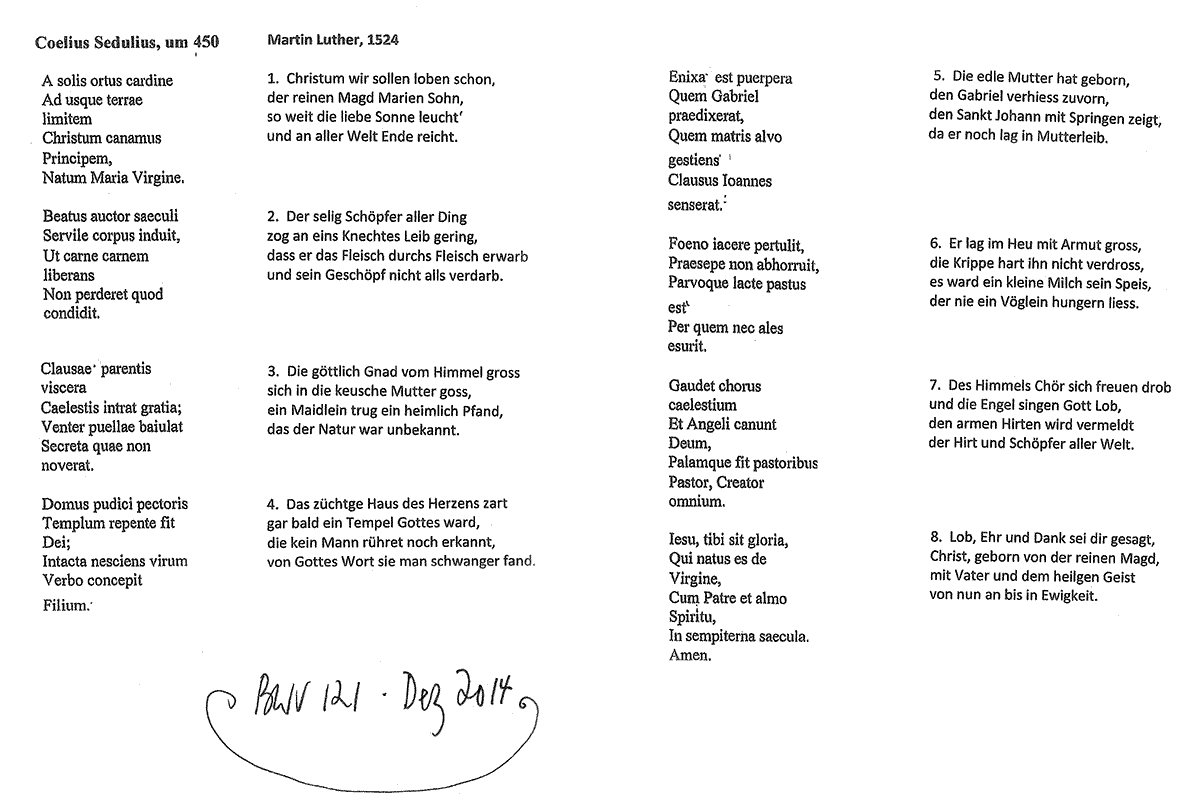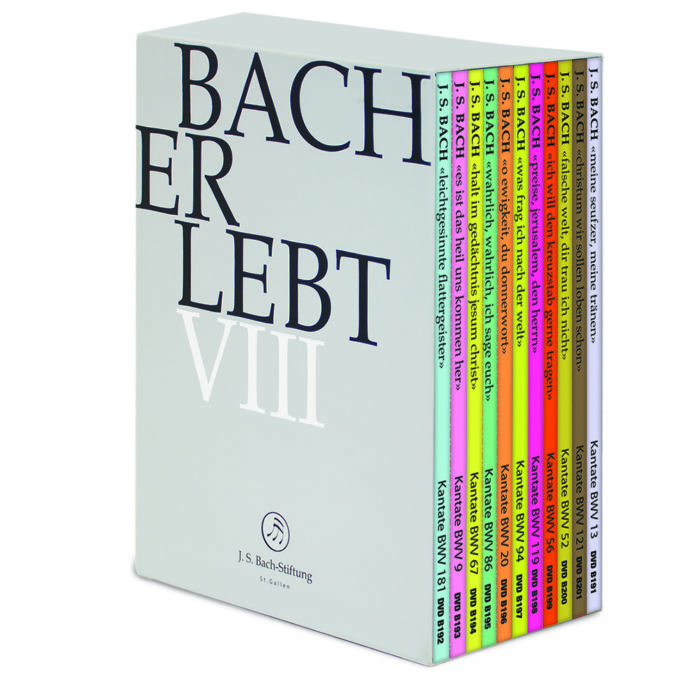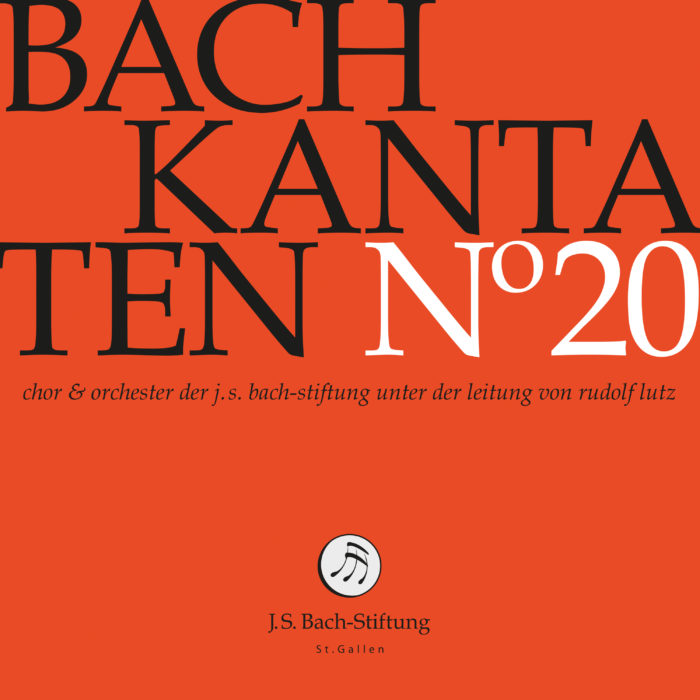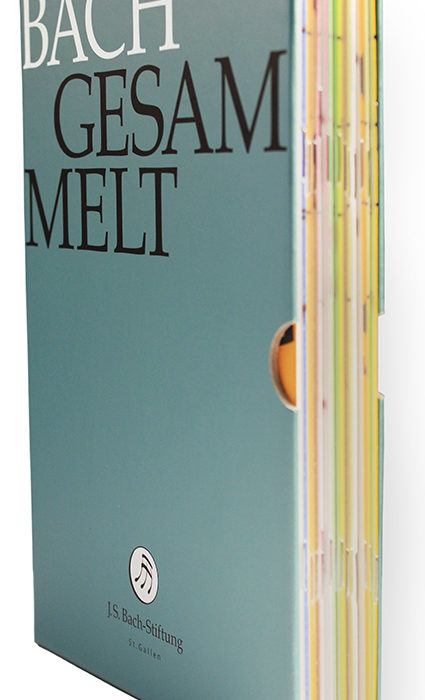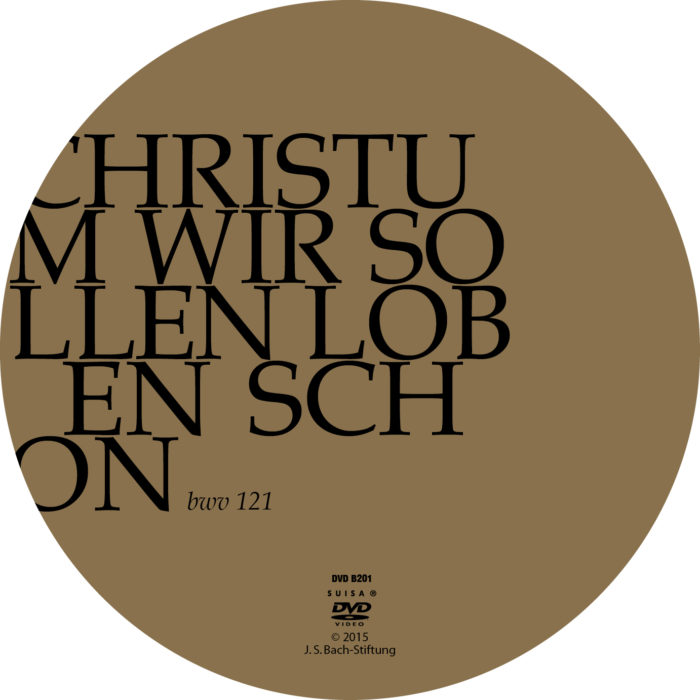Christum wir sollen loben schon
BWV 121 // For the Second Day of Christmas (St Stephen)
(To Christ we should sing praises now) for soprano, alto, tenor and bass, vocal ensemble, zink, trombone I-III, oboe d’ amore, strings and basso continuo
Written for the Second Day of Christmas in 1724, the cantata “Christum wir sollen loben schon” (To Christ we should sing praises now) is distinguished by a stately tone and unusual orchestration that exemplify Bach’s sensitivity to the character of each individual hymn within his chorale cantata cycle.
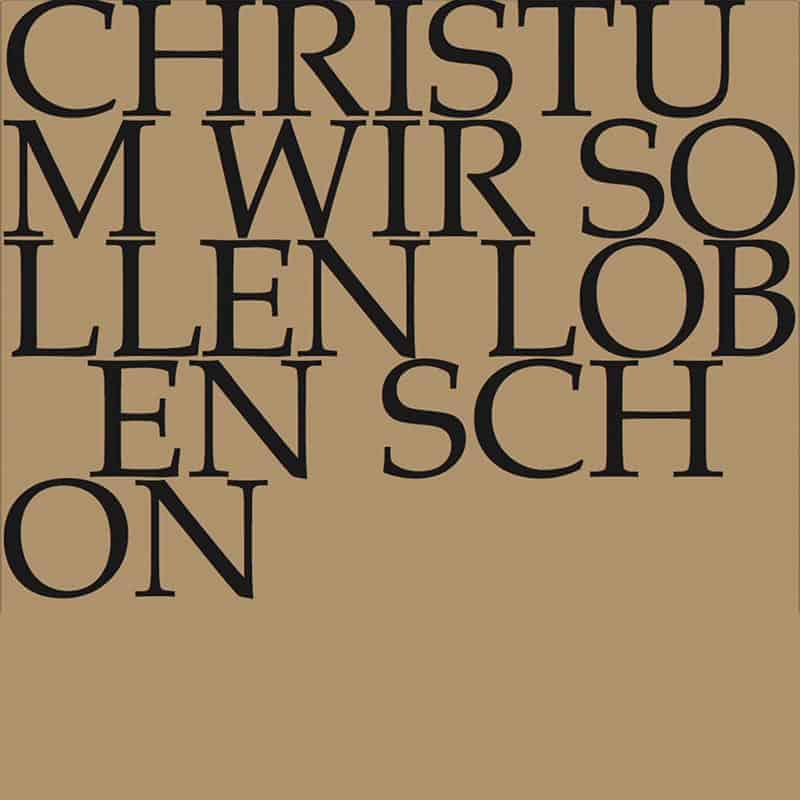
Would you like to enjoy our videos ad-free? Subscribe to YouTube Premium now...
Workshop
Reflective lecture
Choir
Soprano
Susanne Seitter, Gunta Smirnova, Noëmi Tran Rediger, Alexa Vogel, Maria Weber
Alto
Jan Börner, Antonia Frey, Liliana Lafranchi, Alexandra Rawohl, Damaris Rickhaus
Tenor
Marcel Fässler, Manuel Gerber, Raphael Höhn, Nicolas Savoy
Bass
Fabrice Hayoz, Manuel Walser, Tobias Wicky, William Wood
Orchestra
Conductor
Rudolf Lutz
Violin
Plamena Nikitassova, Dorothee Mühleisen, Christine Baumann, Elisabeth Kohler, Christoph Rudolf, Ildiko Sajgo
Viola
Matthias Jäggi, Sarah Krone
Violoncello
Maya Amrein, Hristo Kouzmanov
Violone
Iris Finkbeiner
Oboe d’amore
Andreas Helm
Bassoon
Susann Landert
Trombone
Ulrich Eichenberger, Christian Brühwiler, Wolfgang Schmid
Cornett
Frithjof Smith
Organ
Nicola Cumer
Harpsichord
Jörg Andreas Bötticher
Musical director & conductor
Rudolf Lutz
Workshop
Participants
Karl Graf, Rudolf Lutz
Reflective lecture
Speaker
Dieter Hattrup
Recording & editing
Recording date
12/19/2014
Recording location
Trogen
Sound engineer
Stefan Ritzenthaler
Director
Meinrad Keel
Production manager
Johannes Widmer
Production
GALLUS MEDIA AG, Switzerland
Producer
J.S. Bach Foundation of St. Gallen, Switzerland
Librettist
Text No. 1, 6
Martin Luther, 1524
Text No. 2–5
Text rearranged by an unknown writer
First performance
Second Day of Christmas,
26 December 1724
In-depth analysis
The introductory chorus is set as a fugal chorale motet over a lively bass line that invigorates the harmony; this structure, combined with the doubling of the vocal parts by trombones and cornett, underscores the Gregorian origins of the hymn, a German translation by Martin Luther of the early church song “A solis ortus cardine”. Bach had employed this orchestration on numerous other occasions when setting church-mode and other early hymns, a type of textual interpretation also heard in the works of Georg Philipp Telemann (“Sehet an die Exempel der Alten” TWV 1:1259). By choosing the pithy timbre of the technically demanding Stadtpfeifermusik (town piper music) over the usual concertante orchestral sound, Bach gives the setting an archaic power that lends a glimpse beyond the little babe in the manger to the eternal, almighty figure of Jesus Christ. These 112 bars of contrapuntal magnificence confirm Bach’s interest in the early motet style well before the stile-antico experiments of the 1730s, although the inclusion of strings and woodwinds bestows a touch of modern lustre on the powerful choral sound. The closing phrase – a sustained soprano note above intricate figures – culminates in an “open” half cadence that leaves audiences (both baroque and modern) awaiting a continuation.
The ensuing movement, however, represents an abrupt change in style – a technique also employed on occasion by Zelenka, Bach’s colleague in Dresden. Following the dark magnificence of the chorale motet, the tenor aria is characterised by the elegant timbre of the oboe and its jaunty, syncopated opening motive. Although the theme – a descending leap – initially seems to contradict the wording of the text (“O thou whom God created and extolled”), the middle section to the words “Though great is he, the maker of all nature” reinterprets the motive with an ascending leap. By scoring the movement for oboe d’amore, Bach symbolically underscores the warming love of God.
The alto recitative then launches a surprisingly harsh attack on impertinent human reason. At the same time, it also reveals how difficult it must have been in the days of the emerging Enlightenment to plausibly account for many a time-honoured dogma – also in Lutheran orthodoxy – such as the virgin birth. The problem, however, was certainly not a lack of artistry on Bach’s part – indeed, the master captures the wonder of the immaculate conception and the undeserved nature of God’s act of love in a spectacular and remarkably rapid key progression from C-sharp major to C major.
This is followed by a leaping bass aria with energetic, overlapping tirades from the strings whose dance-like echoing effects lend the movement a touch of gruff ruralness. It appears to be the womenfolk who meet here, in the form of Mary and Elizabeth, and the joyful leaping of John in his mother’s womb certainly represents the promise of new life in general, a feeling that Bach would have known as a father and a Christian. The elegiac middle section then speaks of the supportive “arm of faith”, which the theologian Helene Werthemann with good reason interprets as being the loving mother Mary herself. Overall, the aria embodies a contagious longing for clarity and simplicity, a desire that may well be partly responsible for the pastoral Christmas scenery so beloved over the centuries.
In a setting that touchingly portrays the humility of Jesus and the servility of God, the soprano recitative then addresses the significance the manger holds for the faithful Christian soul. This introduces the “thankful singing” of the closing chorale that, with a return to the modal tonality of the “Lutherised” hymn, concludes the cantata with a stateliness that transcends time and fashion.
Libretto
1. Chor
Christum wir sollen loben schon,
der reinen Magd Marien Sohn,
so weit die liebe Sonne leucht‘
und an aller Welt Ende reicht.
2. Arie (Tenor)
O du von Gott erhöhte Kreatur,
begreife nicht, nein, nein, bewundre nur:
Gott will durch Fleisch des Fleisches Heil erwerben.
Wie groß ist doch der Schöpfer aller Dinge,
und wie bist du verachtet und geringe,
um dich dadurch zu retten vom Verderben.
3. Rezitativ (Altus)
Der Gnade unermeßlichs Wesen
hat sich den Himmel nicht
zur Wohnstatt auserlesen,
weil keine Grenze sie umschließt.
Was Wunder, daß allhie Verstand und Witz gebricht,
ein solch Geheimnis zu ergründen,
wenn sie sich in ein keusches Herze gießt.
Gott wählet sich den reinen Leib zu einem Tempel seiner Ehren,
um zu den Menschen sich mit wundervoller Art zu kehren.
4. Arie (Bass)
Johannis freudenvolles Springen
erkannte dich, mein Jesu, schon.
Nun da ein Glaubensarm dich hält,
so will mein Herze von der Welt
zu deiner Krippe brünstig dringen.
5. Rezitativ (Sopran)
Doch wie erblickt es dich in deiner Krippen?
Es seufzt mein Herz: Mit bebender und fast geschloßner Lippen
bringt es sein dankend Opfer dar.
Gott, der so unermeßlich war,
nimmt Knechtsgestalt und Armut an.
Und weil er dieses uns zugut getan,
so laß ich mit der Engel Chören
ein jauchzend Lob- und Danklied hören.
6. Choral
Lob, Ehr und Dank sei dir gesagt,
Christ, geborn von der reinen Magd,
samt Vater und dem Heilgen Geist
von nun an bis in Ewigkeit.



